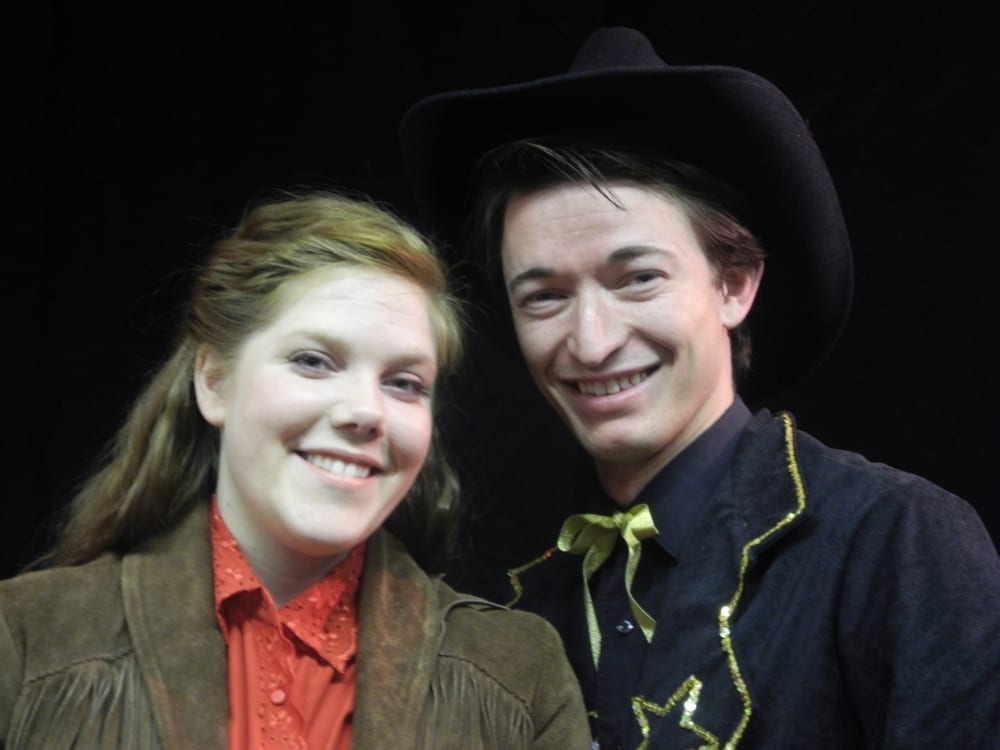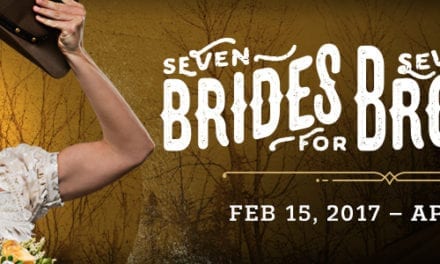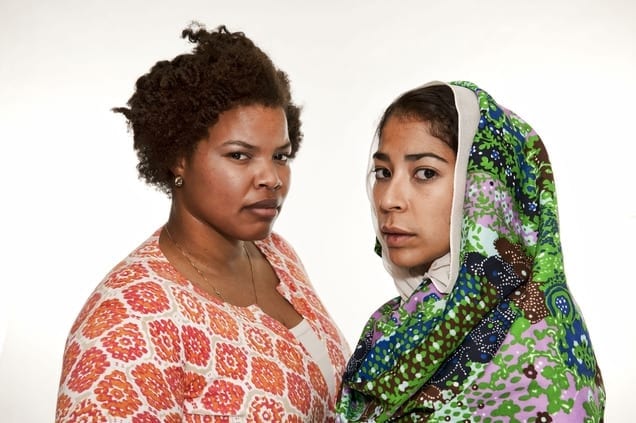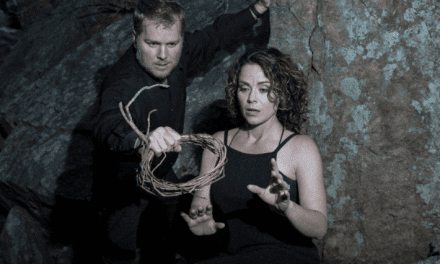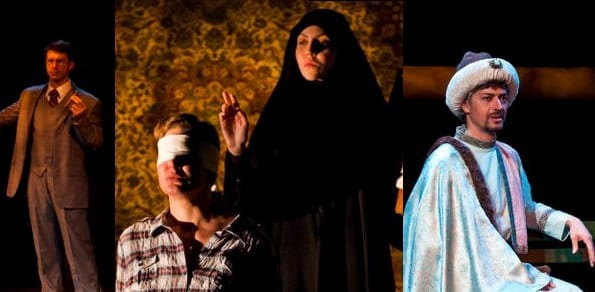RIVERTON — There has been a lot of interest in fellow UTBA writer Callie Oppedisano’s post about community theatre‘s place in the arts. Callie wrote a lot of great things in the post, but one simple statement made me excited for my UTBA assignment this week: “Community theatre in our state is alive and well, if not prospering.” I latched onto this thought because I knew that when I saw the Bluffdale Arts Advisory Board’s production of Annie Get Your Gun, I would be able to put Callie to the test. And after spending an evening watching the production, I have to agree wholeheartedly with Callie. Community theatre truly is prospering in Utah, and I couldn’t be happier about that fact.
Annie Get Your Gun, of course, is the classic musical with a script by Herbert and Dorothy Fields and a score by one of the great American songwriters, Irving Berlin. The story follows legendary sharpshooter Annie Oakley as she meets and falls in love with Frank Butler, but their relationship is endangered by the fact that she’s a better sharpshooter than he is, which creates a rivalry between the two. It’s a simple story, but the score is packed with classic show tunes, including the anthem for the entertainment industry: “There’s No Business Like Show Business.”
The production stars Kate Garner as Annie Oakley. The actress won me over in her first scene with her down home speech patterns and simple dialogue. But she really shines in her singing. Kate Garner’s first song, “Doin’ What Comes Naturally” was (for the first time in my experience) an excellent character song, instead of a cheesy humor song. As the production progressed, each song that Kate Garner sang was more electrifying than the last, and she owned the stage in “I Got the Sun in the Morning,” “Moonshine Lullaby,” and “You Can’t Get a Man with a Gun.” Her counterpart, Frans Lambrechtsen, played Annie’s love interest, Frank Butler. Lambrechtsen was comfortable as the stubborn (if sexist, by modern standards) cowboy and had a nice tenor voice that easily hit all the notes in Berlin’s classic score. Lambrechtsen easily sparred (musically and in dialogue) with Kate Garner and it was easy to enjoy the romance between their two characters.
But Lambrechtsen and Kate Garner were just two of a cast of 95 (ranging from pre-schoolers to senior citizens), many of which are in a play for the first time. Director Laura Garner used as many actors as possible in as many scenes as possible, which gives these amateur actors valuable experience in performing. It must be difficult to handle so many actors, but I was quite impressed by how efficient these actors moved and how free from distraction the children in the cast were. Supporting members of the cast that I was particularly impressed by were Daryl Hunt (who is burdened with most of the exposition with his role of Foster Wilson, but made his lines seem natural), Amber Brill (who was an eccentric and charming Dolly Tate), and the adorable children who played Annie’s younger brothers and sisters. My only suggestion for the cast at large is to sing a little bit louder in some of their songs (like “I Got the Sun in the Morning”) and to project their voices when they have a line. But, the cast was pitch perfect in every song (and the harmonies in “Moonshine Lullaby” were particularly lovely).
The director also did a good job in easing the actors into the songs. One of my pet peeves in watching musicals is when the scene stops dead in its tracks so that the cast can sing a song. Instead, Laura Garner helped the actors link their dialogue to the songs they sang, which especially made “You Can’t Get a Man with a Gun,” “There’s No Business Like Show Business,” and “They Say It’s Wonderful” seem like an indispensable part of the story. I was also impressed that Laura Garner made the creeky, dated script (which, if it were a person, would today be collecting Social Security benefits) more palatable and acceptable to today’s sensitivities about Native Americans and women (without changing any words). The adoption scene was treated with respect towards Native American cultures and was stripped of any offensiveness. Of course, the producers of Annie Get Your Gun had the option of choosing one of the more modern versions of the script, but this would have made it more difficult to have a large cast with many children. The script is also quite funny, and I was impressed by the number of jokes that got laughs from the audience—including myself—which I attribute to Laura Garner’s direction and her lead actors’ comedic timing.
The costumes (designed by Angelle Anderson and Bonnie Stromberg) for this production were excellent, especially for the lead actors. I enjoyed the sparkly touches on Frank’s and Buffalo Bill’s costumes that they wore for the Wild West Show. And the costumes for the entire cast in the ballroom scene were simply gorgeous: all the men where in white, long-tailed tuxedo jackets and black pants; the women were dressed in pastel formal gowns and long white gloves. For the same scene, Annie was dressed in a spectacular red gown with a white fur stole, which was made her visually stand out from the large crowd of actors on the stage. I also thought the set was functional and impressive, especially the tent for Buffalo Bill’s show and the ballroom set. The only major technical hiccups were with the sound, which often had crackling microphones and other issues. But this is a common complaint of reviewers at amateur shows and, because the producers do not actually own or rehearse in their performance space, I’m willing to give them a break.
Finally, I commend the Bluffdale Arts Advisory Board for having a live 21-piece orchestra for their performance. Most amateur musical productions in Utah use recorded music, which is fine, but lacks the magic that comes with a live orchestra. Conductor Scott Pathakis handles his musicians very well, and—despite not having a real orchestra pit—never played so loud that the orchestra overpowered the cast (and I sat quite close to the orchestra). For an amateur production, having a live orchestra can be a gamble, but I’m glad Bluffdale took this gamble because it adds style to a live production. My favorite orchestra moments were during the parade number and “Anything You Can Do, I Can Do Better.”
In the end, Annie Get Your Gun does exactly what an arts council production is supposed to do: strengthen the local community. I smiled as I sat behind a proud set of parents who got excited every time their son was on stage (and in front of a set of grandparents who proudly told me about their four grandchildren in the cast). During intermission, friends and neighbors were mingling about the auditorium and catching up on news about their families and the neighborhood. Most importantly, over 100 actors and musicians were given the chance to learn about theatre and the arts through an unforgettable, practical experience. So, I have to agree with my UTBA colleague, Callie Oppedisano. As long as productions like Bluffdale Arts Advisory Board’s Annie Get Your Gun are being produced, then community theatre is alive and well in Utah. And I couldn’t be happier about it.

